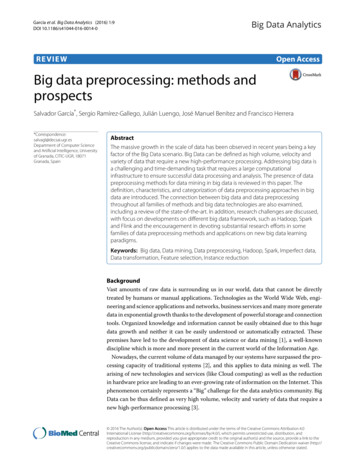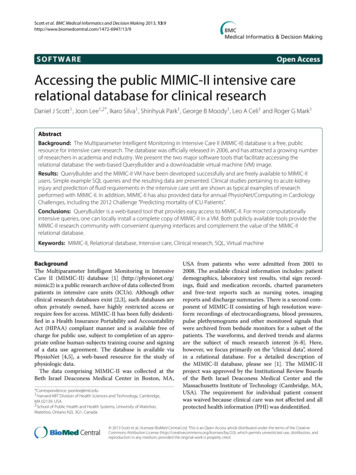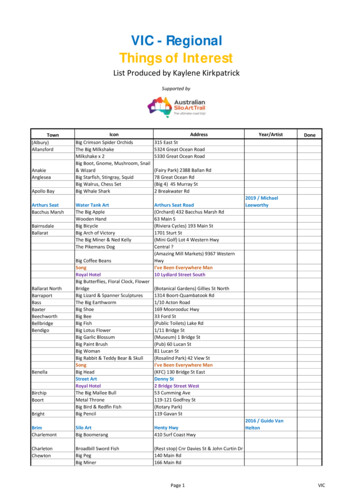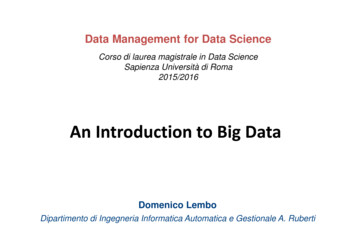
Transcription
García et al. Big Data Analytics (2016) 1:9DOI 10.1186/s41044-016-0014-0Big Data AnalyticsREVIEWOpen AccessBig data preprocessing: methods andprospectsSalvador García* , Sergio Ramírez-Gallego, Julián Luengo, José Manuel Benítez and Francisco ment of Computer Scienceand Artificial Intelligence, Universityof Granada, CITIC-UGR, 18071Granada, SpainAbstractThe massive growth in the scale of data has been observed in recent years being a keyfactor of the Big Data scenario. Big Data can be defined as high volume, velocity andvariety of data that require a new high-performance processing. Addressing big data isa challenging and time-demanding task that requires a large computationalinfrastructure to ensure successful data processing and analysis. The presence of datapreprocessing methods for data mining in big data is reviewed in this paper. Thedefinition, characteristics, and categorization of data preprocessing approaches in bigdata are introduced. The connection between big data and data preprocessingthroughout all families of methods and big data technologies are also examined,including a review of the state-of-the-art. In addition, research challenges are discussed,with focus on developments on different big data framework, such as Hadoop, Sparkand Flink and the encouragement in devoting substantial research efforts in somefamilies of data preprocessing methods and applications on new big data learningparadigms.Keywords: Big data, Data mining, Data preprocessing, Hadoop, Spark, Imperfect data,Data transformation, Feature selection, Instance reductionBackgroundVast amounts of raw data is surrounding us in our world, data that cannot be directlytreated by humans or manual applications. Technologies as the World Wide Web, engineering and science applications and networks, business services and many more generatedata in exponential growth thanks to the development of powerful storage and connectiontools. Organized knowledge and information cannot be easily obtained due to this hugedata growth and neither it can be easily understood or automatically extracted. Thesepremises have led to the development of data science or data mining [1], a well-knowndiscipline which is more and more present in the current world of the Information Age.Nowadays, the current volume of data managed by our systems have surpassed the processing capacity of traditional systems [2], and this applies to data mining as well. Thearising of new technologies and services (like Cloud computing) as well as the reductionin hardware price are leading to an ever-growing rate of information on the Internet. Thisphenomenon certainly represents a “Big” challenge for the data analytics community. BigData can be thus defined as very high volume, velocity and variety of data that require anew high-performance processing [3]. 2016 The Author(s). Open Access This article is distributed under the terms of the Creative Commons Attribution 4.0International License (http://creativecommons.org/licenses/by/4.0/), which permits unrestricted use, distribution, andreproduction in any medium, provided you give appropriate credit to the original author(s) and the source, provide a link to theCreative Commons license, and indicate if changes were made. The Creative Commons Public Domain Dedication waiver ) applies to the data made available in this article, unless otherwise stated.
García et al. Big Data Analytics (2016) 1:9Distributed computing has been widely used by data scientists before the advent ofBig Data phenomenon. Many standard and time-consuming algorithms were replaced bytheir distributed versions with the aim of agilizing the learning process. However, for mostof current massive problems, a distributed approach becomes mandatory nowadays sinceno batch architecture is able to tackle these huge problems.Many platforms for large-scale processing have tried to face the problematic of Big Datain last years [4]. These platforms try to bring closer the distributed technologies to thestandard user (enginners and data scientists) by hiding the technical nuances derived fromdistributed environments. Complex designs are required to create and maintain theseplatforms, which generalizes the use of distributed computing. On the other hand, BigData platforms also requires additional algorithms that give support to relevant tasks, likebig data preprocessing and analytics. Standard algorithms for those tasks must be alsore-designed (sometimes, entirely) if we want to learn from large-scale datasets. It is nottrivial thing and presents a big challenge for researchers.The first framework that enabled the processing of large-scale datasets was MapReduce[5] (in 2003). This revolutionary tool was intended to process and generate huge datasetsin an automatic and distributed way. By implementing two primitives, Map and Reduce,the user is able to use a scalable and distributed tool without worrying about technical nuances, such as: failure recovery, data partitioning or job communication. ApacheHadoop [6, 7] emerged as the most popular open-source implementation of MapReduce,maintaining the aforementioned features. In spite of its great popularity, MapReduce (andHadoop) is not designed to scale well when dealing with iterative and online processes,typical in machine learning and stream analytics [8].Apache Spark [9, 10] was designed as an alternative to Hadoop, capable of performing faster distributed computing by using in-memory primitives. Thanks to its ability ofloading data into memory and re-using it repeatedly, this tool overcomes the problem ofiterative and online processing presented by MapReduce. Additionally, Spark is a generalpurpose framework that thanks to its generality allows to implement several distributedprogramming models on top of it (like Pregel or HaLoop) [11]. Spark is built on top of anew abstraction model called Resilient Distributed Datasets (RDDs). This versatile modelallows controlling the persistence and managing the partitioning of data, among otherfeatures.Some competitors to Apache Spark have emerged lastly, especially from the streamingside [12]. Apache Storm [13] is an open-source distributed real-time processing platform,which is capable of processing millions of tuples per second and node in a fault-tolerantway. Apache Flink [14] is a recent top-level Apache project designed for distributedstream and batch data processing. Both alternatives try to fill the “online” gap left bySpark, which employs a mini-batch streaming processing instead of a pure streamingapproach.The performance and quality of the knowledge extracted by a data mining method inany framework does not only depends on the design and performance of the method butis also very dependent on the quality and suitability of such data. Unfortunately, negative factors as noise, missing values, inconsistent and superfluous data and huge sizesin examples and features highly influence the data used to learn and extract knowledge. It is well-known that low quality data will lead to low quality knowledge [15].Thus data preprocessing [16] is a major and essential stage whose main goal is to obtainPage 2 of 22
García et al. Big Data Analytics (2016) 1:9final data sets which can be considered correct and useful for further data miningalgorithms.Big Data also suffer of the aforementioned negative factors. Big Data preprocessing constitutes a challenging task, as the previous existent approaches cannot be directly appliedas the size of the data sets or data streams make them unfeasible. In this overview wegather the most recent proposals in data preprocessing for Big Data, providing a snapshotof the current state-of-the-art. Besides, we discuss the main challenges on developmentsin data preprocessing for big data frameworks, as well as technologies and new learningparadigms where they could be successfully applied.Data preprocessingThe set of techniques used prior to the application of a data mining method is named asdata preprocessing for data mining [16] and it is known to be one of the most meaningfulissues within the famous Knowledge Discovery from Data process [17, 18] as shown inFig. 1. Since data will likely be imperfect, containing inconsistencies and redundancies isnot directly applicable for a starting a data mining process. We must also mention thefast growing of data generation rates and their size in business, industrial, academic andscience applications. The bigger amounts of data collected require more sophisticatedmechanisms to analyze it. Data preprocessing is able to adapt the data to the requirementsposed by each data mining algorithm, enabling to process data that would be unfeasibleotherwise.Albeit data preprocessing is a powerful tool that can enable the user to treat and processcomplex data, it may consume large amounts of processing time [15]. It includes a widerange of disciplines, as data preparation and data reduction techniques as can be seen inFig. 2. The former includes data transformation, integration, cleaning and normalization;while the latter aims to reduce the complexity of the data by feature selection, instanceFig. 1 KDD processPage 3 of 22
García et al. Big Data Analytics (2016) 1:9Fig. 2 Data preprocessing tasksselection or by discretization (see Fig. 3). After the application of a successful data preprocessing stage, the final data set obtained can be regarded as a reliable and suitable sourcefor any data mining algorithm applied afterwards.Data preprocessing is not only limited to classical data mining tasks, as classificationor regression. More and more researchers in novel data mining fields are paying increasingly attention to data data preprocessing as a tool to improve their models. This wideradoption of data preprocessing techniques is resulting in adaptations of known modelsfor related frameworks, or completely novel proposals.In the following we will present the main fields of data preprocessing, grouping themby their types and showing the current open challenges relative to each one. First, wewill tackle the preprocessing techniques to deal with imperfect data, where missing values and noise data are included. Next, data reduction preprocessing approaches will bepresented, in which feature selection and space transformation are shown. The followingsection will deal with instance reduction algorithms, including instance selection and prototype generation. The last three section will be devoted to discretization, resampling forimbalanced problems and data preprocessing in new fields of data mining respectively.Imperfect dataMost techniques in data mining rely on a data set that is supposedly complete or noisefree. However, real-world data is far from being clean or complete. In data preprocessingit is common to employ techniques to either removing the noisy data or to impute (fill in)the missing data. The following two sections are devoted two missing values imputationand noise filtering.Missing values imputationOne big assumption made by data mining techniques is that the data set is complete.The presence of missing values is, however, very common in the acquisition processes. APage 4 of 22
García et al. Big Data Analytics (2016) 1:9Fig. 3 Data reduction approachesmissing value is a datum that has not been stored or gathered due to a faulty samplingprocess, cost restrictions or limitations in the acquisition process. Missing values cannotbe avoided in data analysis, and they tend to create severe difficulties for practitioners.Missing values treatment is difficult. Inappropriately handling the missing values willeasily lead to poor knowledge extracted and also wrong conclusions [19]. Missing valueshave been reported to cause loss of efficiency in the knowledge extraction process, strongbiases if the missingness introduction mechanism is mishandled and severe complicationsin data handling.Many approaches are available to tackle the problematic imposed by the missing values in data preprocessing [20]. The first option is usually to discard those instances thatmay contain a missing value. However, this approach is rarely beneficial, as eliminatinginstances may produce a bias in the learning process, and important information canbe discarded [21]. The seminal works on data imputation come from statistics. Theymodel the probability functions of the data and take into account the mechanisms thatinduce missingness. By using maximum likelihood procedures, they sample the approximate probabilistic models to fill the missing values. Since the true probability model fora particular data sets is usually unknown, the usage of machine learning techniques hasbecome very popular nowadays as they can be applied avoiding without providing anyprior information.Noise treatmentData mining algorithms tend to assume that any data set is a sample of an underlying distribution with no disturbances. As we have seen in the previous section, data gatheringPage 5 of 22
García et al. Big Data Analytics (2016) 1:9is rarely perfect, and corruptions often appear. Since the quality of the results obtainedby a data mining technique is dependent on the quality of the data, tackling the problemof noise data is mandatory [22]. In supervised problems, noise can affect the input features, the output values or both. When noise is present in the input attributes, it is usuallyreferred as attribute noise. The worse case is when the noise affects the output attribute,as this means that the bias introduced will be greater. As this kind of noise has been deeplystudied in classification, it is usually known as class noise.In order to treat noise in data mining, two main approaches are commonly used in thedata preprocessing literature. The first one is to correct the noise by using data polishingmethods, specially if it affects the labeling of an instance. Even partial noise correction isclaimed to be beneficial [23], but it is a difficult task and usually limited to small amountsof noise. The second is to use noise filters, which identify and remove the noisy instancesin the training data and do no require the data mining technique to be modified.Dimensionality reductionWhen data sets become large in the number of predictor variables or the number ofinstances, data mining algorithms face the curse of dimensionality problem [24]. It is aserious problem as it will impede the operation of most data mining algorithms as thecomputational cost rise. This section will underline the most influential dimensionalityreduction algorithms according to the division established into Feature Selection (FS) andspace transformation based methods.Feature selectionFeature selection (FS) is “the process of identifying and removing as much irrelevant andredundant information as possible” [25]. The goal is to obtain a subset of features fromthe original problem that still appropriately describe it. This subset is commonly usedto train a learner, with added benefits reported in the specialized literature [26, 27]. FScan remove irrelevant and redundant features which may induce accidental correlationsin learning algorithms, diminishing their generalization abilities. The use of FS is alsoknown to decrease the risk of over-fitting in the algorithms used later. FS will also reducethe search space determined by the features, thus making the learning process faster andalso less memory consuming.The use FS can also help in task not directly related to the data mining algorithm appliedto the data. FS can be used in the data collection stage, saving cost in time, sampling,sensing and personnel used to gather the data. Models and visualizations made from datawith fewer features will be easier to understand and to interpret.Space transformationsFS is not the only way to cope with the curse of dimensionality by reducing the numberof dimensions. Instead of selecting the most promising features, space transformationtechniques generate a whole new set of features by combining the original ones. Such acombination can be made obeying different criteria. The first approaches were based onlinear methods, as factor analysis [28] and PCA [29].More recent techniques try to exploit nonlinear relations among the variables. Someof the most important, both in relevance and usage, space transformation proceduresare LLE [30], ISOMAP [31] and derivatives. They focus on transforming the originalPage 6 of 22
García et al. Big Data Analytics (2016) 1:9set of variables into a smaller number of projections, sometimes taking into account thegeometrical properties of clusters of instances or patches of the underlying manifolds.Instance reductionA popular approach to minimize the impact of very large data sets in data mining algorithms is the use of Instance Reduction (IR) techniques. They reduce the size of the dataset without decreasing the quality of the knowledge that can be extracted from it. Instancereduction is a complementary task regarding FS. It reduces the quantity of data by removing instances or by generating new ones. In the following we describe the most importantinstance reduction and generation algorithms.Instance selectionNowadays, instance selection is perceived as necessary [32]. The main problem ininstance selection is to identify suitable examples from a very large amount of instancesand then prepare them as input for a data mining algorithm. Thus, instance selection iscomprised by a series of techniques that must be able to choose a subset of data thatcan replace the original data set and also being able to fulfill the goal of a data miningapplication [33, 34]. It must be distinguished between instance selection, which implies asmart operation of instance categorization, from data sampling, which constitutes a morerandomized approach [16].A successful application of instance selection will produce a minimum data subsetthat it is independent from the data mining algorithm used afterwards, without losingperformance. Other added benefits of instance selection is to remove noisy and redundant instances (cleaning), to allow data mining algorithms to operate with large data sets(enabling) and to focus on the important part of the data (focusing).Instance generationInstance selection methods concern the identification of an optimal subset of representative objects from the original training data by discarding noisy and redundant examples.Instance generation methods, by contrast, besides selecting data, can generate and replacethe original data with new artificial data. This process allows it to fill regions in the domainof the problem, which have no representative examples in original data, or to condensate large amounts of instances in less examples. Instance generation methods are oftencalled prototype generation methods, as the artificial examples created tend to act as arepresentative of a region or a subset of the original instances [35].The new prototypes may be generated following diverse criteria. The simplest approachis to relabel some examples, for example those that are suspicious of belonging to awrong class label. Some prototype generation methods create centroids by merging similar examples, or by first merging the feature space in several regions and then creatinga set of prototype for each one. Others adjust the position of the prototypes through thespace, by adding or substracting values to the prototype’s features.DiscretizationData mining algorithms require to know the domain and type of the data that will be usedas input. The type of such data may vary, from categorical where no order among thevalues can be established, to numerical data where the order among the values there exist.Page 7 of 22
García et al. Big Data Analytics (2016) 1:9Decision trees, for instance, make split based on information or separability measures thatrequire categorical values in most cases. If continuous data is present, the discretizationof the numerical features is mandatory, either prior to the tree induction or during itsbuilding process.Discretization is gaining more and more consideration in the scientific community [36]and it is one of the most used data preprocessing techniques. It transforms quantitativedata into qualitative data by dividing the numerical features into a limited number of nonoverlapped intervals. Using the boundaries generated, each numerical value is mappedto each interval, thus becoming discrete. Any data mining algorithm that needs nominaldata can benefit from discretization methods, since many real-world applications usuallyproduce real valued outputs. For example, three of the ten methods considered as the topten in data mining [37] need an external or embedded discretization of data: C4.5 [38],Apriori [39] and Naïve Bayes [40] In these cases, discretization is a crucial previous stage.Discretization also produce added benefits. The first is data simplification and reduction, helping to produce a faster and more accurate learning. The second is readability,as discrete attributes are usually easier to understand, use and explain [36]. Nevertheless these benefits come at price: any discretization process is expected to generate a lossof information. Minimizing this information loss is the main goal pursused by the discretizer, but an optimal discretization is a NP-complete process. Thus, a wide range ofalternatives are available in the literature as we can see in some published reviews on thetopic [36, 41, 42].Imbalanced learning. Undersampling and oversampling methodsIn many supervised learning applications, there is a significant difference between theprior probabilities of different classes, i.e., between the probabilities with which an example belongs to the different classes of the classification problem. This situation is knownas the class imbalance problem [43]. The hitch with imbalanced datasets is that standardclassification learning algorithms are often biased towards the majority class (known asthe “negative” class) and therefore there is a higher misclassification rate for the minorityclass instances (called the “positive” examples).While algorithmic modifications are available for imbalanced problems, our interestlies in preprocessing techniques to alleviate the bias produced by standard data miningalgorithms. These preprocessing techniques proceed by resampling the data to balancethe class distribution. The main advantage is that they are independent of the data miningalgorithm applied afterwards.Two main groups can be distinguished within resampling. The first one is undersampling methods, which create a subset of the original dataset by eliminating (majority)instances. The second one is oversampling methods, which create a superset of the originaldataset by replicating some instances or creating new instances from existing ones.Non-heuristic techniques, as random-oversampling or random-undersampling wereinitially proposed, but they tend to discard information or induce over-fitting. Amongthe more sophisticated, heuristic approaches, “Synthetic Minority Oversampling TEchnique” (SMOTE) [44] has become one of the most renowned approaches in this area.It interpolates several minority class examples that lie together. Since SMOTE can stillinduce over-fitting in the learner, its combination with a plethora of sampling methods can be found in the specialized literature with excellent results. Under-sampling hasPage 8 of 22
García et al. Big Data Analytics (2016) 1:9the advantage of producing reduced data sets, and thus interesting approaches basedon neighborhood methods, clustering and even evolutionary algorithms have been successfully applied to generate quality balanced training sets by discarding majority classexamples.Data preprocessing in new data mining fieldsMany data preprocessing methods have been devised to work with supervised data, sincethe label provides useful information that facilitates data transformation. However, thereare also preprocessing approaches for unsupervised problems.For instance, FS has attracted much attention lately for unsupervised problems [45–47]or missing values imputation [48]. Semisupervised classification, which containsinstances both labeled and unlabeled, also shows several works in preprocessing fordiscretization [49], FS [46], instance selection [50] or missing values imputation [51].Multi-label classification is a framework prone to gather imbalanced problems. Thus,methods for re-sampling these particular data sets have been proposed [52, 53]. Multiinstance problems are also challenging, and resampling strategies have been also studiedfor them [54]. Data streams are also a challenging area of data mining, since the information represented may change with time. Nevertheless, data streams are attracting muchattention and for instance preprocessing approaches for imputing missing values [55, 56],FS [57] and IR [58] have been recently proposed.Big data preprocessingThis section aims at detailing a thorough list of contributions on Big Data preprocessing. Table 1 classifies these contributions according to the category of data preprocessing,number of features, number of instances, maximum data size managed by each algorithmand the framework under they have been developed. The size has been computed multiplying the total number features by the number of instances (8 bytes per datum). Forsparse methods (like [59] or [60]), only the non-sparse cells have been considered. Figure 4depicts an histogram of the methods using the size variable. It can be observed as most ofmethods have only been tested against datasets between zero an five gigabytes, and fewapproaches have been tested against truly large-scale datasets.Once seen a snapshot of the current developments in Big Data preprocessing, we willgive shorts descriptions of the contributions in the rest of this section. First, we describeone of the most popular machine learning library for Big Data: MLlib; which brings awide range of data preprocessing techniques to the Spark community. Next the rest ofsections will be devoted to enumerate those contributions presented in the literature, andcategorized and arranged in the Table 1.MLlib: a spark machine learning libraryMLlib [61] is a powerful machine learning library that enables the use of Spark in the dataanalytics field. This library is formed by two packages: mllib : this is the first version of MLlib, which was built on top of RDDs. It containsthe majority of the methods proposed up to now. ml : it comes with the newest features of MLlib for constructing ML pipelines. Thishigher-level API is built on enhanced DataFrames structures [62].Page 9 of 22
García et al. Big Data Analytics (2016) 1:9Page 10 of 22Table 1 Analyzed methods and the maximum data size managed by each oneMethodsCategory# Features# InstancesSize (GB)Framework[70]FS63065,003,913305.1196Hadoop MapReduce[69]FS63065,003,913305.1196Hadoop 0,09519,264,0974.1623C S1001,600,0001.1921Apache Spark[80]FS1271,131,5711.0707Hadoop MapReduce[71]FS54,6752,0960.8538Hadoop MapReduce[75]FS54581,0120.2338Hadoop –0.0976Hadoop MapReduce[79]FS25638,2320.0729Hadoop MapReduce[68]FS525,2530.0020Hadoop MapReduce[78]FS––0.0000Hadoop MapReduce[67]FS––0.0000Hadoop MapReduce[72]FS––0.0000Hadoop MapReduce[83]Imbalanced63032,000,000150.2037Hadoop MapReduce[84]Imbalanced63032,000,000150.2037Hadoop MapReduce[90]Imbalanced63016,000,00075.1019Apache Spark[89]Imbalanced414,856,1511.4834Hadoop MapReduce[82]Imbalanced414,000,0001.2219Hadoop MapReduce[81]Imbalanced141,432,9410.1495Hadoop MapReduce[86]Imbalanced9,7311,4460.1048Hadoop MapReduce[91]Imbalanced14524,1310.0547Hadoop MapReduce[87]Imbalanced3695,0480.0255Hadoop MapReduce[88]Imbalanced82,687,2800.0200Hadoop e (Twister)[92]Incomplete481191,7790.6873Hadoop ache Spark[96]discretization63065,003,913305.1196Apache Spark[94]discretization––4.0000Hadoop MapReduce[97]IR414,856,1511.4834Hadoop MapReduceThe methods are grouped by preprocessing task, and ordered by maximum data size. Those methods with no information aboutnumber of features or instances have been set to zero sizeFig. 4 Maximum data size managed by each preprocessing method (in gigabytes)
García et al. Big Data Analytics (2016) 1:9Here, we describe and classify all data preprocessing techniques for both versions1into five categories: discretization and normalization, feature extraction, feature selection,feature indexers and encoders, and text mining.Discretization and normalizationDiscretization transforms continuous variables using discrete intervals, whereas normalization just performs an adjustment of distributions. Binarizer: converts numerical features to binary features. This method makes theassumption that data follows a Bernoulli distribution. If a given feature is greater thana threshold it yields a 1.0, if not, a 0.0. Bucketizer: discretizes a set of continuous features by using buckets. The userspecifies the number of buckets. Discrete Cosine Transform: transforms a real-valued sequence in the time domaininto another real-valued sequence (with the same size) in the frequency domain. Normalizer: normalizes each row to have unit norm. It uses parameter p, whichspecifies the p -norm used. StandardScaler: normalizes each feature so that it follows a normal distribution. MinMaxScaler: normalizes each feature to a specific range, using two parameters: thelower and the upper bound. ElementwiseProduct: scales each feature by a scalar multiplier.Feature extractionFeature extraction techniques combine the original set of features to obtain a new setof less-redundant variables [63]. For example, by using projections to low-dimensional
Garcíaetal.BigDataAnalytics (2016) 1:9 Big Data Analytics DOI10.1186/s41044-016-0014- REVIEW OpenAccess Bigdatapreprocessing:methodsand prospects . Spark, which employs a mini-batch streaming processing instead of a pure streaming . imbalanced problems are more noteworthy in Big Data environments where millions










